Deep Learning from Scratch - Neural Network
Activation Function
입력 신호의 총합을 출력 신호로 변환하는 함수를 활성화 함수(activation function)이라고 한다. 신호의 총합을 계산하고 활성화 함수에 입력해 결과를 내는 2단계로 나눠보면
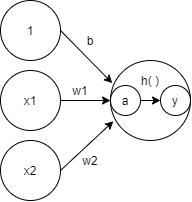
import numpy as np
import matplotlib.pyplot as plt
import warnings
warnings.filterwarnings('ignore')
Step Function
def step_function(x):
y = x > 0
return y.astype(np.int)
x = np.array([-1.0, 1.0, 2.0])
step_function(x)
array([0, 1, 1])
x = np.arange(-5.0, 5.0, 0.1)
y = step_function(x)
plt.plot(x,y)
plt.ylim(-0.1, 1.1)
plt.show()
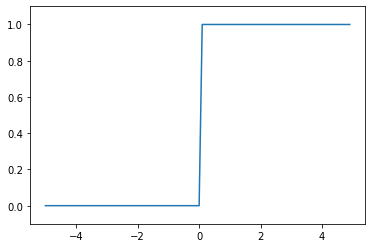
Sigmoid Function
def sigmoid(x):
return 1 / (1 + np.exp(-x))
x = np.array([-1.0, 1.0, 2.0])
sigmoid(x)
array([0.26894142, 0.73105858, 0.88079708])
x = np.arange(-5.0, 5.0, 0.1)
y = sigmoid(x)
plt.plot(x, y)
plt.ylim(-0.1, 1.1)
plt.show()
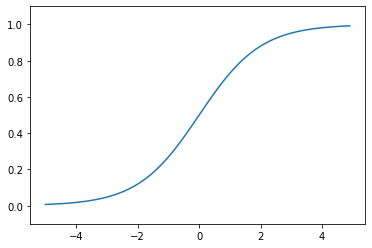
ReLU
def relu(x):
return np.maximum(0, x)
x = [-5, 0, 4]
y = relu(x)
plt.plot(x, y)
plt.ylim(-1, 5)
plt.show()
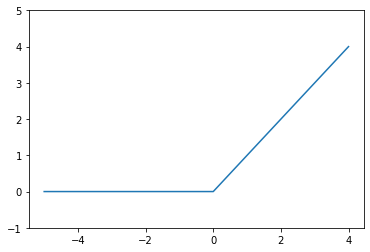
신경망에서의 행렬 곱
X = np.array([1, 2])
print(X, X.shape)
[1 2] (2,)
W = np.array([[1,3,5], [2,4,6]])
print(W, W.shape)
[[1 3 5]
[2 4 6]] (2, 3)
Y = np.dot(X, W)
print(Y, Y.shape)
[ 5 11 17] (3,)
3층 신경망 구현하기
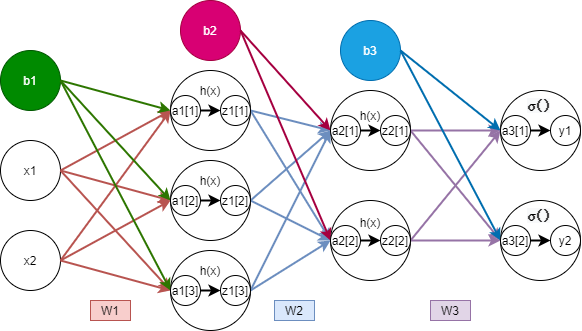
def identity_function(x):
return x
def init_network():
network = {}
network['W1'] = np.array([[.1, .3, .5], [.2, .4, .6]])
network['b1'] = np.array([.1, .2, .3])
network['W2'] = np.array([[.1, .4], [.2, .5], [.3, .6]])
network['b2'] = np.array([.1, .2])
network['W3'] = np.array([[.1, .3], [.2, .4]])
network['b3'] = np.array([.1, .2])
return network
def forward(network, x):
W1, W2, W3 = network['W1'], network['W2'], network['W3']
b1, b2, b3 = network['b1'], network['b2'], network['b3']
a1 = np.dot(x, W1) + b1
z1 = sigmoid(a1)
a2 = np.dot(z1, W2) + b2
z2 = sigmoid(a2)
a3 = np.dot(z2, W3) + b3
y = identity_function(a3)
return y
network = init_network()
x = np.array([1.0, 0.5])
y = forward(network, x)
print(y)
[0.31682708 0.69627909]
출력층 설계하기
Identity Function
입력 신호가 그대로 출력 신호가 된다.
Softmax Function

$n$은 출력층의 뉴런 수, $y_{k}$는 그중 $k$번째 출력임을 뜻한다. softmax 함수의 분자는 입력 신호 $a_{k}$의 지수 함수, 분모는 모든 입력 신호의 지수 함수의 합으로 구성된다.
a = np.array([.3, 2.9, 4.0])
exp_a = np.exp(a)
print(exp_a)
[ 1.34985881 18.17414537 54.59815003]
sum_exp_a = np.sum(exp_a)
print(sum_exp_a)
74.1221542101633
y = exp_a / sum_exp_a
print(y)
[0.01821127 0.24519181 0.73659691]
def softmax(a):
exp_a = np.exp(a)
sum_exp_a = np.sum(exp_a)
y = exp_a / sum_exp_a
return y
주의점
softmax 함수는 지수 함수를 사용하기 때문에 큰 값은 inf가 되어 돌아오고 오버플로 문제가 발생할 수 있다.
softmax 함수를 개선해보면,
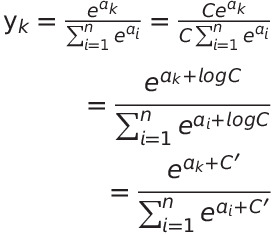
a = np.array([1010, 1000, 990])
np.exp(a) / np.sum(np.exp(a))
array([nan, nan, nan])
c = np.max(a)
a - c
array([ 0, -10, -20])
np.exp(a-c) / np.sum(np.exp(a - c))
array([9.99954600e-01, 4.53978686e-05, 2.06106005e-09])
단순히 softmax로 계산하게 되면 nan이 출력된다. 하지만 입력 신호 중 최댓값을 빼주면 올바르게 계산할 수 있으며 이를 구현하면
def softmax(a):
c = np.max(a)
exp_a = np.exp(a - c)
sum_exp_a = np.sum(exp_a)
y = exp_a / sum_exp_a
return y
Softmax Function 특징
a = np.array([.3, 2.9, 4.0])
y = softmax(a)
print(y, np.sum(y))
[0.01821127 0.24519181 0.73659691] 1.0
Softmax function은 0에서 1.0 사이의 실수이다. 또한 총합은 1이 된다. 이 성질 덕분에 출력을 확률로 해석할 수 있다. 또한 softmax function을 적용해도 출력이 가장 큰 뉴런의 위치는 달라지지 않는다. 결과적으로 신경망으로 분류할때는 출력층의 softmax function을 생략해도 된다.
MNIST
import tensorflow as tf
import matplotlib.pyplot as plt
import pickle
import time
def plot_img(img):
img = np.uint8(img)
plt.imshow(img.reshape(28, 28))
def get_data():
mnist = tf.keras.datasets.mnist
(x_train, y_train), (x_test, y_test) = mnist.load_data()
x_train = x_train.reshape(-1, 784)
x_test = x_test.reshape(-1, 784)
return x_test, y_test
img, _ = get_data()
plot_img(img[1])
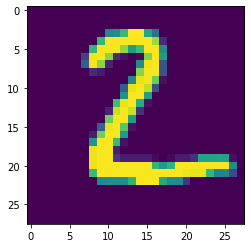
def init_network():
with open('sample_weight.pkl', 'rb') as f:
network = pickle.load(f)
return network
def predict(network, x):
W1, W2, W3 = network['W1'], network['W2'], network['W3']
b1, b2, b3 = network['b1'], network['b2'], network['b3']
a1 = np.dot(x, W1) + b1
z1 = sigmoid(a1)
a2 = np.dot(z1, W2) + b2
z2 = sigmoid(a2)
a3 = np.dot(z2, W3) + b3
y = softmax(a3)
return y
network = init_network()
x, t = x_test, y_test
start_time = time.time()
accuracy_cnt = 0
for i in range(len(x)):
y = predict(network, x[i])
p = np.argmax(y)
if p == t[i]:
accuracy_cnt += 1
end_time = time.time()
no_batch_time = end_time - start_time
print('Accuracy: '+str(float(accuracy_cnt) / len(x)), f', time elapsed : {end_time - start_time}')
Accuracy: 0.9207 , time elapsed : 1.0659980773925781
Batch 처리
x, _ = get_data()
network = init_network()
W1, W2, W3 = network['W1'], network['W2'], network['W3']
x.shape
(10000, 784)
print(x[0].shape, W1.shape, W2.shape, W3.shape)
(784,) (784, 50) (50, 100) (100, 10)
x, t = get_data()
network = init_network()
batch_size = 100
accuracy_cnt = 0
start_time = time.time()
for i in range(0, len(x), batch_size):
x_batch = x[i:i+batch_size]
y_batch = predict(network, x_batch)
p = np.argmax(y_batch, axis=1)
accuracy_cnt += np.sum(p == t[i:i+batch_size])
end_time = time.time()
batch_time = end_time - start_time
print('Accuracy: '+str(float(accuracy_cnt) / len(x)), f', time elapsed : {end_time - start_time}')
print(f'Time saved {np.round((no_batch_time - batch_time), 6)} seconde')
Accuracy: 0.9207 , time elapsed : 0.06101250648498535
Time saved 1.004986 seconde
Keras
from tensorflow.keras.layers import Dense, Input
from tensorflow.keras.models import Model
from tensorflow.keras.utils import to_categorical
x_train, y_train, x_test, y_test = get_data()
x_train.shape
(60000, 784)
y_train_categorical = to_categorical(y_train)
inputs = Input(shape=(784, ))
d = Dense(50, activation ='sigmoid')(inputs)
d = Dense(100, activation='sigmoid')(d)
d = Dense(10, activation='softmax')(d)
model = Model(inputs, d)
model.summary()
Model: "functional_10"
_________________________________________________________________
Layer (type) Output Shape Param #
=================================================================
input_7 (InputLayer) [(None, 784)] 0
_________________________________________________________________
dense_16 (Dense) (None, 50) 39250
_________________________________________________________________
dense_17 (Dense) (None, 100) 5100
_________________________________________________________________
dense_18 (Dense) (None, 10) 1010
=================================================================
Total params: 45,360
Trainable params: 45,360
Non-trainable params: 0
_________________________________________________________________
model.compile(loss='mse', optimizer='adam')
start_time = time.time()
hist = model.fit(x_train, y_train_categorical, epochs = 20)
end_time = time.time()
print(f'time elapsed {end_time - start_time}')
Epoch 1/20
1875/1875 [==============================] - 2s 809us/step - loss: 0.0317
Epoch 2/20
1875/1875 [==============================] - 2s 812us/step - loss: 0.0202
Epoch 3/20
1875/1875 [==============================] - 2s 820us/step - loss: 0.0187
Epoch 4/20
1875/1875 [==============================] - 2s 823us/step - loss: 0.0177
Epoch 5/20
1875/1875 [==============================] - 2s 814us/step - loss: 0.0177
Epoch 6/20
1875/1875 [==============================] - 2s 829us/step - loss: 0.0173
Epoch 7/20
1875/1875 [==============================] - 2s 826us/step - loss: 0.0166
Epoch 8/20
1875/1875 [==============================] - 2s 819us/step - loss: 0.0159
Epoch 9/20
1875/1875 [==============================] - 2s 817us/step - loss: 0.0148
Epoch 10/20
1875/1875 [==============================] - 2s 823us/step - loss: 0.0152
Epoch 11/20
1875/1875 [==============================] - 2s 821us/step - loss: 0.0143
Epoch 12/20
1875/1875 [==============================] - 2s 841us/step - loss: 0.0142
Epoch 13/20
1875/1875 [==============================] - 2s 823us/step - loss: 0.0137
Epoch 14/20
1875/1875 [==============================] - 2s 844us/step - loss: 0.0133
Epoch 15/20
1875/1875 [==============================] - 2s 858us/step - loss: 0.0128
Epoch 16/20
1875/1875 [==============================] - 2s 854us/step - loss: 0.0128
Epoch 17/20
1875/1875 [==============================] - 2s 833us/step - loss: 0.0126
Epoch 18/20
1875/1875 [==============================] - 2s 826us/step - loss: 0.0129
Epoch 19/20
1875/1875 [==============================] - 2s 819us/step - loss: 0.0123
Epoch 20/20
1875/1875 [==============================] - 2s 830us/step - loss: 0.0122
time elapsed 31.24882459640503
predict = model.predict(x_test)
predicted_label = predict.argmax(axis=1)
cnt = 0
for i in range(len(predicted_label)):
if (predicted_label[i] == y_test[i]):
cnt += 1
print(f'Accuracy : {cnt / len(predicted_label) * 100}')
Accuracy : 91.57
Torch
import torch
import torch.nn as nn
import torch.nn.functional as F
import torch.optim as optim
from torchvision import datasets, transforms
class dnn(nn.Module):
def __init__(self):
super(dnn, self).__init__()
self.d1 = nn.Linear(784, 50)
self.d2 = nn.Linear(50, 100)
self.d3 = nn.Linear(100, 10)
def forward(self, x):
x = x.float()
h1 = F.sigmoid(self.d1(x.view(-1, 784)))
h2 = F.sigmoid(self.d2(h1))
return F.softmax(h2, dim=1)
transform = transforms.Compose([transforms.ToTensor(), transforms.Normalize((0.1307, ), (0.3081, ))])
train_loader = torch.utils.data.DataLoader(datasets.MNIST('../data', train=True, download=True, transform=transform))
test_loader = torch.utils.data.DataLoader(datasets.MNIST('../data', train=False, download=True, transform=transform))
model = dnn()
optimizer = optim.Adam(model.parameters())
no_cuda = True
use_cuda = not no_cuda and torch.cuda.is_available()
device = torch.device("cuda" if use_cuda else "cpu")
batch_size = 64
interval = 20000
epoch = 10
def train(interval, model, device, train_loader, optimizer, epoch):
model.train()
for batch_idx, (data, target) in enumerate(train_loader):
data, target = data.to(device), target.to(device)
optimizer.zero_grad()
output = model(data)
loss = F.nll_loss(output, target)
loss.backward()
optimizer.step()
if batch_idx % interval == 0:
print('Train Epoch: {} [{}/{} ({:.0f}%)]\tLoss: {:.6f}'.format(epoch, batch_idx * len(data), len(train_loader.dataset),100. * batch_idx / len(train_loader), loss.item()))
def test(interval, model, device, test_loader):
model.eval()
test_loss = 0
correct = 0
with torch.no_grad():
for data, target in test_loader:
data, target = data.to(device), target.to(device)
output = model(data)
test_loss += F.nll_loss(output, target, reduction='sum').item()
pred = output.argmax(dim=1, keepdim=True)
correct += pred.eq(target.view_as(pred)).sum().item()
test_loss /= len(test_loader.dataset)
print('\nTest set: Average loss: {:.4f}, Accuracy: {}/{} ({:.0f}%)\n'.format(test_loss, correct, len(test_loader.dataset),100. * correct / len(test_loader.dataset)))
for epoch in range(1, 11):
train(interval, model, device, train_loader, optimizer, epoch)
test(interval, model, device, test_loader)
Train Epoch: 1 [0/60000 (0%)] Loss: -0.008938
Train Epoch: 1 [20000/60000 (33%)] Loss: -0.025429
Train Epoch: 1 [40000/60000 (67%)] Loss: -0.025821
Test set: Average loss: -0.0254, Accuracy: 1034/10000 (10%)
Train Epoch: 2 [0/60000 (0%)] Loss: -0.025665
Train Epoch: 2 [20000/60000 (33%)] Loss: -0.026105
Train Epoch: 2 [40000/60000 (67%)] Loss: -0.025847
Test set: Average loss: -0.0257, Accuracy: 8315/10000 (83%)
Train Epoch: 3 [0/60000 (0%)] Loss: -0.025708
Train Epoch: 3 [20000/60000 (33%)] Loss: -0.026541
Train Epoch: 3 [40000/60000 (67%)] Loss: -0.026278
Test set: Average loss: -0.0259, Accuracy: 8550/10000 (86%)
Train Epoch: 4 [0/60000 (0%)] Loss: -0.026034
Train Epoch: 4 [20000/60000 (33%)] Loss: -0.026690
Train Epoch: 4 [40000/60000 (67%)] Loss: -0.026271
Test set: Average loss: -0.0259, Accuracy: 8810/10000 (88%)
Train Epoch: 5 [0/60000 (0%)] Loss: -0.026035
Train Epoch: 5 [20000/60000 (33%)] Loss: -0.026684
Train Epoch: 5 [40000/60000 (67%)] Loss: -0.026274
Test set: Average loss: -0.0259, Accuracy: 8695/10000 (87%)
Train Epoch: 6 [0/60000 (0%)] Loss: -0.026662
Train Epoch: 6 [20000/60000 (33%)] Loss: -0.026507
Train Epoch: 6 [40000/60000 (67%)] Loss: -0.026301
Test set: Average loss: -0.0260, Accuracy: 8914/10000 (89%)
Train Epoch: 7 [0/60000 (0%)] Loss: -0.026341
Train Epoch: 7 [20000/60000 (33%)] Loss: -0.026646
Train Epoch: 7 [40000/60000 (67%)] Loss: -0.026506
Test set: Average loss: -0.0260, Accuracy: 8853/10000 (89%)
Train Epoch: 8 [0/60000 (0%)] Loss: -0.026542
Train Epoch: 8 [20000/60000 (33%)] Loss: -0.026723
Train Epoch: 8 [40000/60000 (67%)] Loss: -0.026484
Test set: Average loss: -0.0260, Accuracy: 8787/10000 (88%)
Train Epoch: 9 [0/60000 (0%)] Loss: -0.026377
Train Epoch: 9 [20000/60000 (33%)] Loss: -0.026722
Train Epoch: 9 [40000/60000 (67%)] Loss: -0.026350
Test set: Average loss: -0.0260, Accuracy: 8703/10000 (87%)
Train Epoch: 10 [0/60000 (0%)] Loss: -0.026281
Train Epoch: 10 [20000/60000 (33%)] Loss: -0.026713
Train Epoch: 10 [40000/60000 (67%)] Loss: -0.026708
Test set: Average loss: -0.0260, Accuracy: 8549/10000 (85%)
참고 : 사이토 고키, 『DeepLearning from Scratch』, 한빛미디어(2020), p63-105